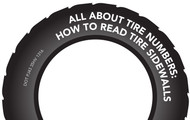All About Tire Numbers: How to Read Tire Sidewalls
31st Oct 2016

When the rubber meets the road, any number of things can go wrong -- at least, over time. Tires get worn down with extended use, and every tire has a life cycle that means it will eventually need to be replaced before it becomes a danger to you and others on the road. Regular tire rotation will help keep your tires from getting worn down too quickly, but once you do need to get that replacement, ask yourself: do you really know what tire you’re supposed to be using? If you don’t, the answer is pretty easy to find. It’s right on your tire!
Unless you have significant tire sidewall damage, your tire sidewall will have several sets of numbers and letters that tell you everything you need to know about the tire, its size, and its history. This is a pretty good measure of what kind of tire you need when you’re ready to replace them. If you’re in the process of changing out factory tires or simply, worn out tires, this is also a great opportunity to get the right kind of tires the first time and every time.
Reading Your Tire Sidewall
There’s probably a good chance you’ve never bent down there and taken a look at your tire’s sidewall before. For the most part, this is what the auto shop does for you when they replace your tires. But it’s a good rule of thumb to know this information yourself, as it helps you find the best deals on tires, especially if you’re shopping for them online. There are 7 separate sections to your tire sidewall. Some of this information you may not use as readily or as often, but it’s helpful to know. Your sidewall indicates:
- Tire Size in metric or High Flotation System for trucks
- US DOT and safety standards
- Tire construction type
- Load index and speed rating
- Treadwear, traction and temperature resistance
- Maximum load limit and air pressure requirements
- Ply construction
- Rotation direction
For each of these sections, the coding can look very different. It typically consists of a string of numbers and letters, each which represent something different, depending on the section.
Check out our interactive image below, click on each of the red buttons to learn more about the tire letters and numbers:
Tire Size Numbers
This is one of the most important numbers for most drivers. There are several numbers and letters you'll need to familiarize yourself with here. Understanding these should help you better understand any tire size chart you see.
A typical tire sidewall code may look like this:
P185/60R14 82H
These numbers represent all of the following:
| Tire Type |
Tire Width |
Aspect Ratio |
Construction |
|
Wheel Diameter |
Load Index | Speed Rating |
DOT |
The first letter(s) indicate what type of vehicle the tire is designed for. A “P” indicates that the tire is designed for a passenger vehicle. An “LT” would indicate that the tires are for a light truck. It’s important to get the right type in this case.
Tire width is indicated by the group of numbers that come before the backslash. In millimeters, this measures the width of the tire from the inner and outer tire sidewalls. In our example, this means that the 185 millimeters wide . Although a common misconception, wider tires are not better for traction. Tire width has a bigger impact on braking, cornering, and straight line acceleration, with wider tires better at cornering, while thinner tires are better at braking and straight line acceleration.
The first letter(s) indicate what type of vehicle the tire is designed for. A “P” indicates that the tire is designed for a passenger vehicle. An “LT” would indicate that the tires are for a light truck. It’s important to get the right type in this case.
Immediately after the backslash is the tire aspect ratio. This number represents, as a percent, the size difference between the sidewall height and the tire width. Our example has “60” . This means the tire sidewall is 60% the size of the tire width. That means it’s 111 millimeters.
The tire aspect ratio has an impact on the steering stability. A lower aspect ratio results in less stability for the tire. This can have an impact when driving in rain or on snow.
The letter immediately following the aspect ratio is the tire construction code. This indicates the fabric construction on the inside of the tire. You’ll find either an “R” for radial, “D” for diagonal or “B” for bias belt. The type of tire construction has a significant impact on its strength, heat resistance, and several other factors. In our example, an “R” is used. This means it is a radial tire. Radial tires tend to provide better gas mileage and have a long lifespan than other types, such as bias belt tires.
The next set of numbers is fairly simple to understand. Here you have the wheel diameter, this time in inches. This number indicates, not the size of the tire, but the size of the wheel that the tire is designed to fit. Our example has a wheel diameter of 14 inches. This means our tire is designed to fit a 14-inch wheel.
Immediately following the space, the first number you see is the load index. This number can range from 0 to 279 and indicates the tire's carrying capacity. Each number from 1-279 represents a weight limit amount. The numbers themselves do not indicate a weight limit. For example, a load limit of 0 = 99 lbs. A load limit of 1 = 102 lbs. Passenger vehicle tires typically have load limits that go up to 150, which would be 7,385 lbs.
Our example has a tire load capacity of 82. This means a tire load capacity of 1,047 lbs.
The final letter ending the tire size code indicates the speed rating. For the most part, these letters are alphabetical, starting with B and ending at Z. H, however, is out of order, and indicates its own speed rating. Our example uses “H”, which indicates a speed rating of 130 mph. The speed rating indicates the max speed the tire can carry the load before failing.
The following chart defines the speed ratings:
| B- Up to 31 mph | L- Up to 75 mph | U- Up to 124 mph |
| C- Up to 37 mph | M- Up to 81 mph | H- Up to 130 mph |
| D- Up to 40 mph | N- Up to 87 mph | V- Up to 149 mph |
| E- Up to 43 mph | P- Up to 94 mph | W- Up to 168 mph |
| F- up to 50 mph | Q- Up to 100 mph | Y- Up to 186 mph |
| G- Up to 56 mph | R- Up to 106 mph | Z- 149 mph and over |
| J- Up to 62 mph | S- Up to 112 mph | |
| K- Up to 68 mph | T- Up to 118 mph |
All tires are required to have a serial number that includes which week of the year the tire was manufactured and the year it was manufactured. On your tire, there may be a section that looks like this:
DOT PJ43 35HV 1316
The last four numbers are the ones tire consumers should care the most about. The first two digits, “13”, indicates the week of the year - 13th week. The last two digit indicates the year - “16”, or “2016”. As the month can change depending on the year, for 2016, the 13th week is the last week in March. You can use this to help determine if your own tires are out of date, or if the tires you’ve purchased are still good.
Now that you know all about tire numbers, enter to win a Safety Seal SSKAP Auto Tire Repair Kit so you can repair any tire on-the-go! Giveaway runs until 11:59 PM EST, November 9th, 2016.



